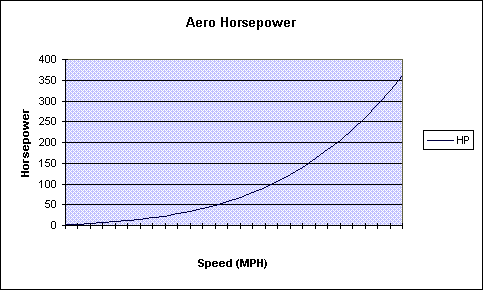SOFTWARE
Aero
Spreadsheet
|
Aerodynamics
and vehicle performance Aerodynamics in relation to vehicle
performance is one of the latest areas of attention. Carmakers didn't start paying
attention to drag coefficient on production cars until the late 70's - early '80's. In the
'60's and early '70's, racers started to realize the gains to be made at higher speeds. An
excellent (albeit drastic) example of tuning production car aerodynamics for the racetrack
is the Plymouth Superbird
Aerodynamics has little to do with acceleration until you get to higher speeds (80mph or so), so in your street car (Z, Maxima, SE-R, Porsche 911Turbo) you will gain little at the strip with aerodynamic changes. You may pick up measurable MPH in the quarter mile, but not ET. The horsepower required to overcome drag is not linear (see graph below). Take a car with a Cd (Coefficient of drag) of .40, frontal area of 20sq. ft, 150 DRIVE wheel horsepower, and correct gearing, it's top speed is approx. 135mph. Double your power to 300hp, and you end up with 173mph - 100% more power, 28% more top speed. Above 140mph or so, you may get as much return on aerodynamic improvements as horsepower gains. Take the 150hp engine, stick it into a slicker car (Cd .30, same frontal area) and you get 149mph with the same drivetrain. That's an additional 15 mph from zero extra horsepower! Put another way, if your car has a Cd of .40 (and many older cars are worse than this, a stock 240Z is about .465). to add 10MPH top speed from 140 to 150MPH, you need a 35 horsepower gain, AT THE DRIVE WHEELS, just to overcome the aerodynamic drag. Driveline losses are typically 15-20%, so that makes over 40 crankshaft horsepower for a 10 MPH gain. Then throw in frictional losses, (and friction increases with speed, all those bearings spinning faster and faster), and you can see that where 120mph is easy, 150 is much harder. Here's a graph showing the curve for aerodynamics to give you a better idea of the curve involved :
For a given amount of horsepower, frontal area, and coefficient of drag (.Cd), and correct gearing, you will have a calculable top speed, almost regardless of weight (increased rolling friction from heavier weights comes into play in comparatively small amounts). An example would be : 150hp and Cd of .40 = top speed 135. Weight? It's not nearly as critical, as long as you're geared to make your 150hp at 135mph, and have enough gears in between to get you there. The amount of TIME required to get to 135 will vary due to weight, but absolute top speed will very only a small amount. "What about those huge wings that race cars have?" Those wings create DOWNFORCE, which add traction by applying weight to the tires (see traction article) , increasing available traction, but they sure don't help top speed one bit (although there is something to be said for STABILITY at high speed). In fact, at many race tracks they have to balance desired downforce with top speed - they can have it fast on the straights, or add cornering grip at the expense of top speed. The Lamborghini Countach, with its wild front and rear wings, loses more than 10mph of top speed (I think I saw a magazine article claim 174 for no wings and 160 with them). A big whale-tail on your car is unlikely to perform any better, and the only speeds that it will increase traction are speeds you car is either unable to attain, or speeds you probably don't want to corner very hard at (I like cornering hard, but not at 130MPH on the street). |

